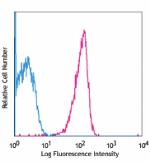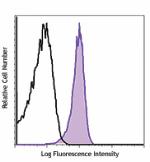- Clone
- 122 (See other available formats)
- Regulatory Status
- RUO
- Workshop
- HCDM listed
- Other Names
- TR2, Herpesvirus entry mediator A, Tumor necrosis factor receptor superfamily, member 14, TNFRSF14, Tumor necrosis factor receptor like 2, HVEM
- Isotype
- Mouse IgG1, κ
- Barcode Sequence
- TGATAGAAACAGACC
- Ave. Rating
- Submit a Review
- Product Citations
- publications
| Cat # | Size | Price | Quantity Check Availability | Save | ||
|---|---|---|---|---|---|---|
| 318821 | 10 µg | 296€ | ||||
The 122 antibody recognizes human HVEM also known as herpesvirus entry mediator A, tumor necrosis factor receptor superfamily, member 14, TNFRSF14, and tumor necrosis factor receptor like 2. HVEM, a member of the TNFR superfamily, is a type I transmembrane protein containing 2 TNF receptor domains with a predicted molecular weight of approximately 30 kD. HVEM is widely expressed in blood vessels, brain, heart, kidney, liver, lung, prostate, spleen, thymus and other organs. Resting T cells and naïve and memory B cells express high levels of HVEM as well. In humans, HVEM is not expressed in germinal center B cells. Immature dendritic cells express high levels of HVEM that is downregulated upon maturation. HVEM plays an important role in herpes simplex virus pathogenesis by enhancing entry into cells. Signaling through HVEM activates JNK1, NF-κB and AP-1 to control gene expression in response to infection or cellular stress and activate the immune response. HVEM binds to LIGHT and has also been shown to associate with several other proteins including TRAF1, TRAF2, TRAF3, TRAF5, B and T lymphocyte associated protein (BTLA), and estrogen receptor alpha.
Product DetailsProduct Details
- Verified Reactivity
- Human
- Reported Reactivity
- African Green, Baboon, Cynomolgus, Rhesus
- Antibody Type
- Monoclonal
- Host Species
- Mouse
- Immunogen
- Recombinant human HVEM protein
- Formulation
- Phosphate-buffered solution, pH 7.2, containing 0.09% sodium azide and EDTA
- Preparation
- The antibody was purified by chromatography and conjugated with TotalSeq™-D oligomer under optimal conditions.
- Concentration
- 0.5 mg/mL
- Storage & Handling
- The antibody solution should be stored undiluted between 2°C and 8°C. Do not freeze.
- Application
-
PG - Quality tested
- Recommended Usage
-
Each lot of this antibody is quality control tested by immunofluorescent staining with flow cytometric analysis and the oligomer sequence is confirmed by sequencing. TotalSeq™-D antibodies are compatible with Mission Bio’s Tapestri Single-Cell Sequencing Platform for simultaneous detection of DNA and Protein.
To maximize performance, it is strongly recommended that the reagent be titrated for each application, and that you centrifuge the antibody dilution before adding to the cells at 14,000xg at 2 - 8°C for 10 minutes. Carefully pipette out the liquid avoiding the bottom of the tube and add to the cell suspension. For Proteogenomics analysis, the suggested starting amount of this reagent for titration is ≤ 1.0 µg per million cells in 100 µL volume. Refer to the corresponding TotalSeq™ protocol for specific staining instructions.
Buyer is solely responsible for determining whether Buyer has all intellectual property rights that are necessary for Buyer's intended uses of the BioLegend TotalSeq™ products. For example, for any technology platform Buyer uses with TotalSeq™, it is Buyer's sole responsibility to determine whether it has all necessary third party intellectual property rights to use that platform and TotalSeq™ with that platform. - Application Notes
-
The 122 antibody has been shown to be useful for flow cytometry, Western blot, and ELISA.
- Additional Product Notes
-
TotalSeq™-D reagents are designed to profile protein expression at single cell level. The Mission Bio Tapestri platform and sequencer (e.g. Illumina analyzers) are required. Please contact technical support for more information, or visit biolegend.com/totalseq/single-cell-dna
The barcode flanking sequences are CGAGATGACTACGCTACTCATGG (PCR handle), and GAGCCGATCTAGTATCTCAGT*C*G (capture sequence). * indicates a phosphorothioated bond, to prevent nuclease degradation.
View more applications data for this product in our Application Technical Notes. - Application References
- RRID
-
AB_2894618 (BioLegend Cat. No. 318821)
Antigen Details
- Structure
- Member of the TNFR superfamily, type I transmembrane protein containing 2 TNF receptor domains. Predicted molecular weight approximately 30 kD.
- Distribution
-
Widely expressed in blood vessels, brain, heart, kidney, liver, lung, prostate, spleen, thymus and other organs. Resting T cells and naïve and memory B cells express high levels of HVEM. Immature dendritic cells express high levels of HVEM that is downregulated upon maturation.
- Function
- Plays an important role in herpes simplex virus pathogenesis by enhancing entry into cells. Signaling through HVEM activates JNK1, NF-κB and AP-1 to control gene expression in response to infection or cellular stress and activate the immune response.
- Interaction
- TRAF1, TRAF2, TRAF3, TRAF5, B and T lymphocyte associated protein (BTLA), and estrogen receptor alpha have been shown to directly interact with HVEM in vivo.
- Ligand/Receptor
- LIGHT (TNFSF14), LTα
- Cell Type
- B cells, Dendritic cells, T cells
- Biology Area
- Cell Adhesion, Cell Biology, Immunology, Signal Transduction
- Molecular Family
- Adhesion Molecules, CD Molecules
- Antigen References
-
1. Carfi A, et al. 2001. Molec. Cell 8:169.
2. Gonzalez LC, et al. 2005.Proc. Nat. Acad. Sci. 102:1116.
3. Kwon BS, et al. 1997. J. Biol. Chem. 272:13471.
4. Marsters SA, et al. 1997. J. Biol. Chem. 272:14272.
5. Montgomery RI, et al. 1996. Cell 87:427. - Gene ID
- 8764 View all products for this Gene ID
- UniProt
- View information about CD270 on UniProt.org
Related FAQs
Other Formats
View All CD270 Reagents Request Custom Conjugation| Description | Clone | Applications |
|---|---|---|
| Purified anti-human CD270 (HVEM, TR2) | 122 | FC,WB,ELISA |
| PE anti-human CD270 (HVEM, TR2) | 122 | FC |
| APC anti-human CD270 (HVEM, TR2) | 122 | FC |
| PE/Cyanine7 anti-human CD270 (HVEM, TR2) | 122 | FC |
| PerCP/Cyanine5.5 anti-human CD270 (HVEM, TR2) | 122 | FC |
| TotalSeq™-A0020 anti-human CD270 (HVEM, TR2) | 122 | PG |
| TotalSeq™-C0020 anti-human CD270 (HVEM, TR2) | 122 | PG |
| PE/Dazzle™ 594 anti-human CD270 (HVEM, TR2) | 122 | FC |
| TotalSeq™-B0020 anti-human CD270 (HVEM, TR2) | 122 | PG |
| TotalSeq™-D0020 anti-human CD270 (HVEM, TR2) | 122 | PG |
Compare Data Across All Formats
This data display is provided for general comparisons between formats.
Your actual data may vary due to variations in samples, target cells, instruments and their settings, staining conditions, and other factors.
If you need assistance with selecting the best format contact our expert technical support team.
-
Purified anti-human CD270 (HVEM, TR2)

Human peripheral blood lymphocytes stained with purified 122... -
PE anti-human CD270 (HVEM, TR2)

Human peripheral blood lymphocytes stained with 122 PE -
APC anti-human CD270 (HVEM, TR2)

Human peripheral blood lymphocytes were stained with CD270 (... -
PE/Cyanine7 anti-human CD270 (HVEM, TR2)

Human peripheral blood lymphocytes were stained with CD270 (... -
PerCP/Cyanine5.5 anti-human CD270 (HVEM, TR2)

Human peripheral blood lymphocytes were stained with CD270 (... -
TotalSeq™-A0020 anti-human CD270 (HVEM, TR2)
-
TotalSeq™-C0020 anti-human CD270 (HVEM, TR2)
-
PE/Dazzle™ 594 anti-human CD270 (HVEM, TR2)

Human peripheral blood lymphocytes were stained with CD19 (c... -
TotalSeq™-B0020 anti-human CD270 (HVEM, TR2)
-
TotalSeq™-D0020 anti-human CD270 (HVEM, TR2)
 Login / Register
Login / Register 













Follow Us